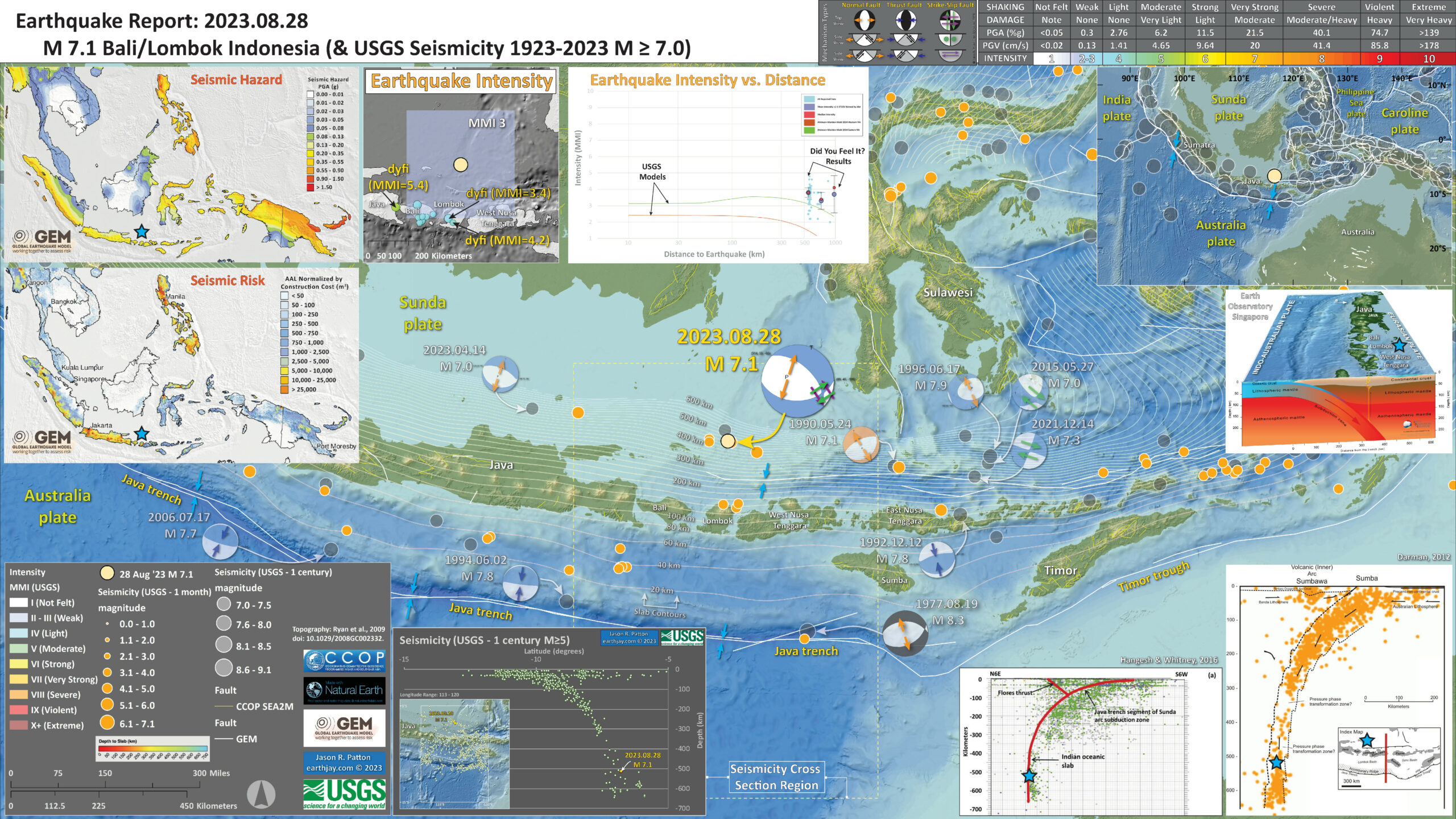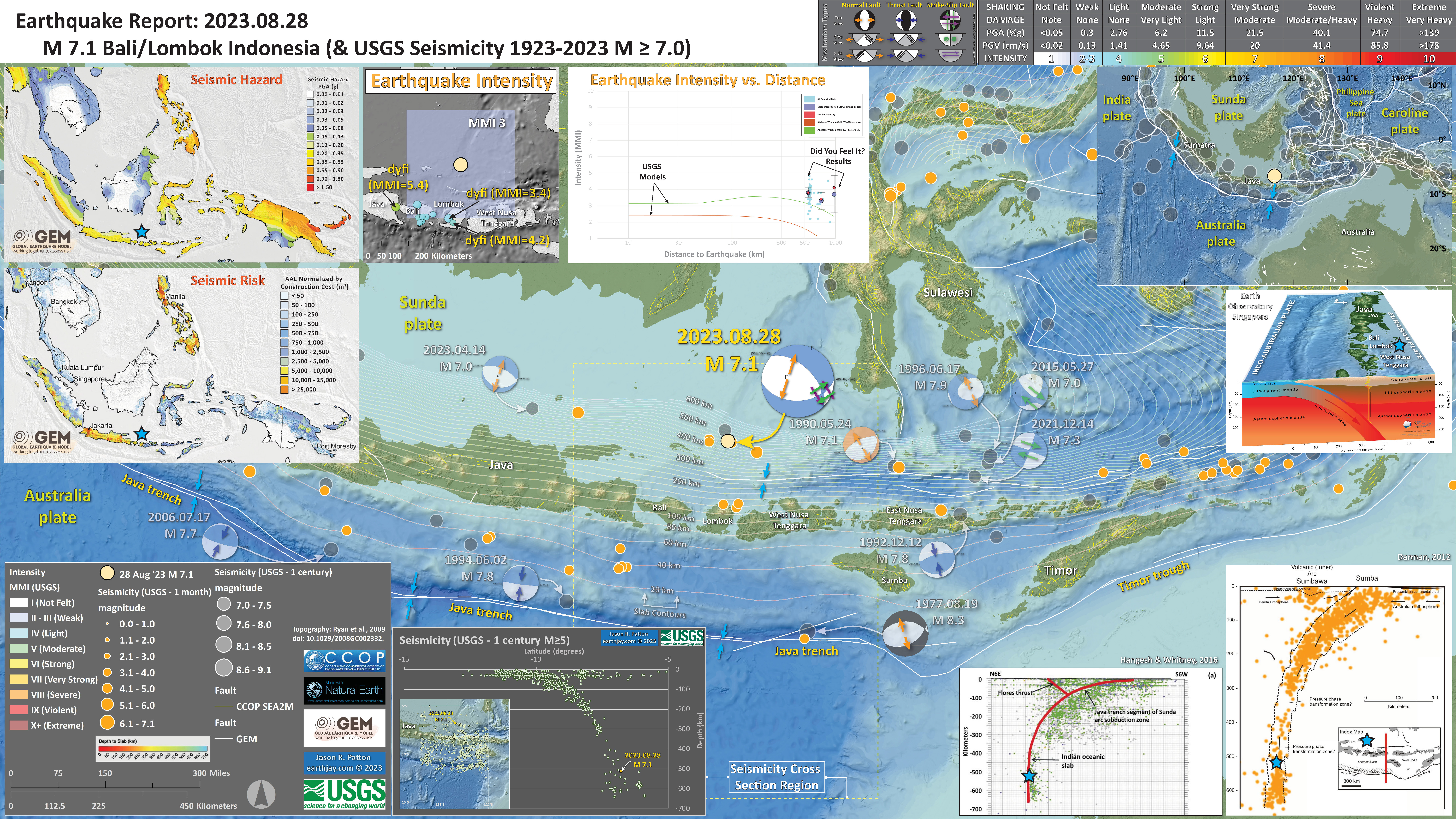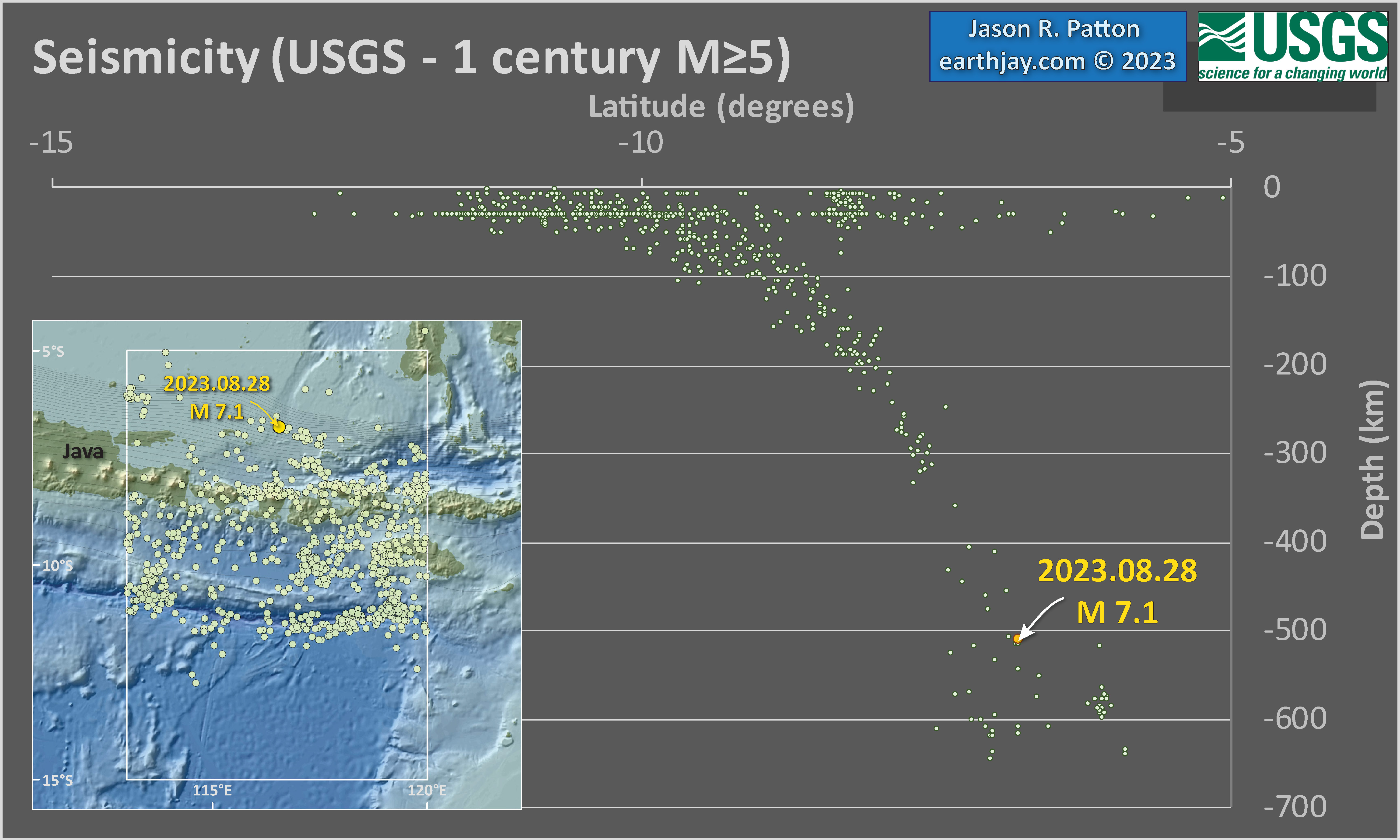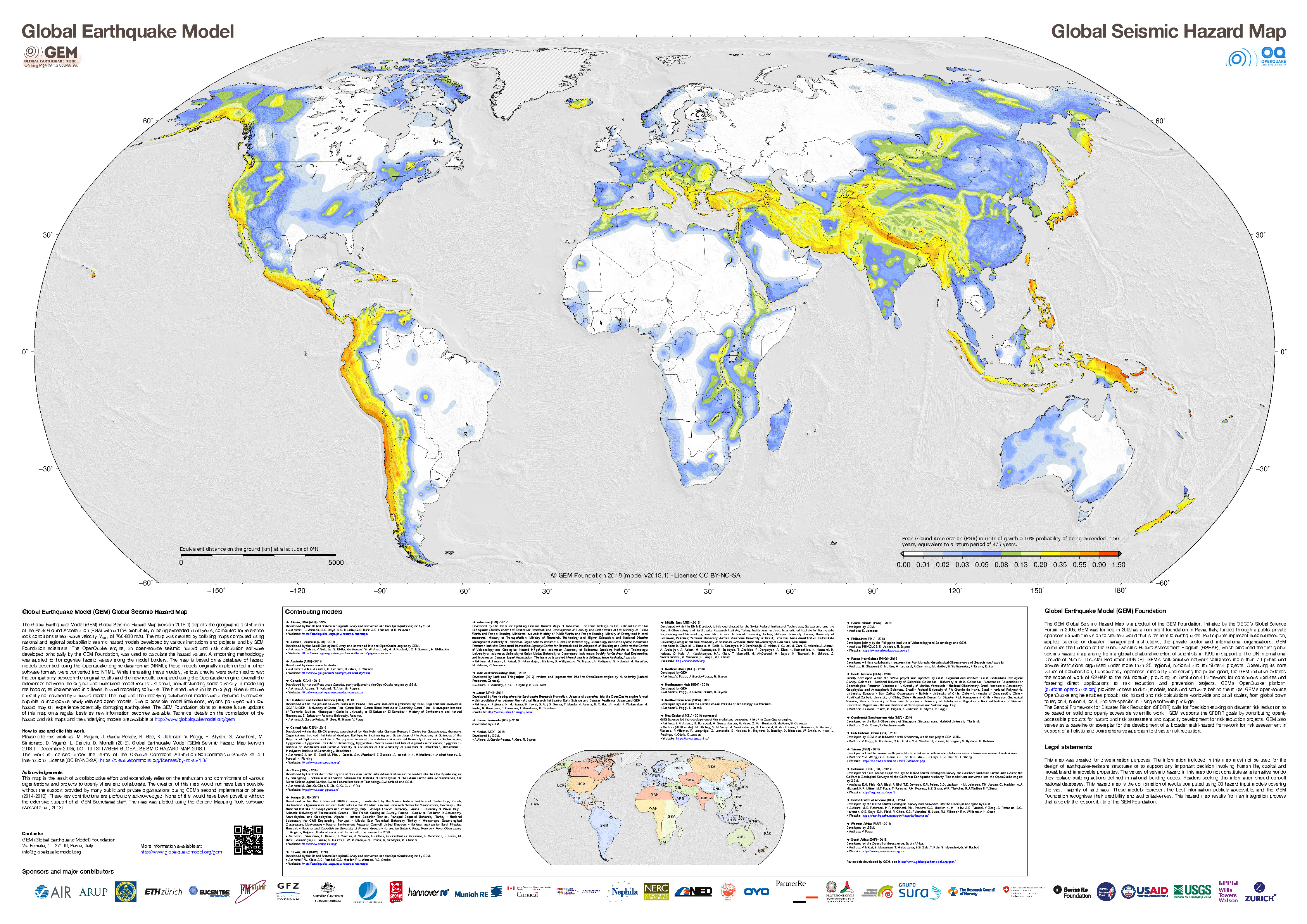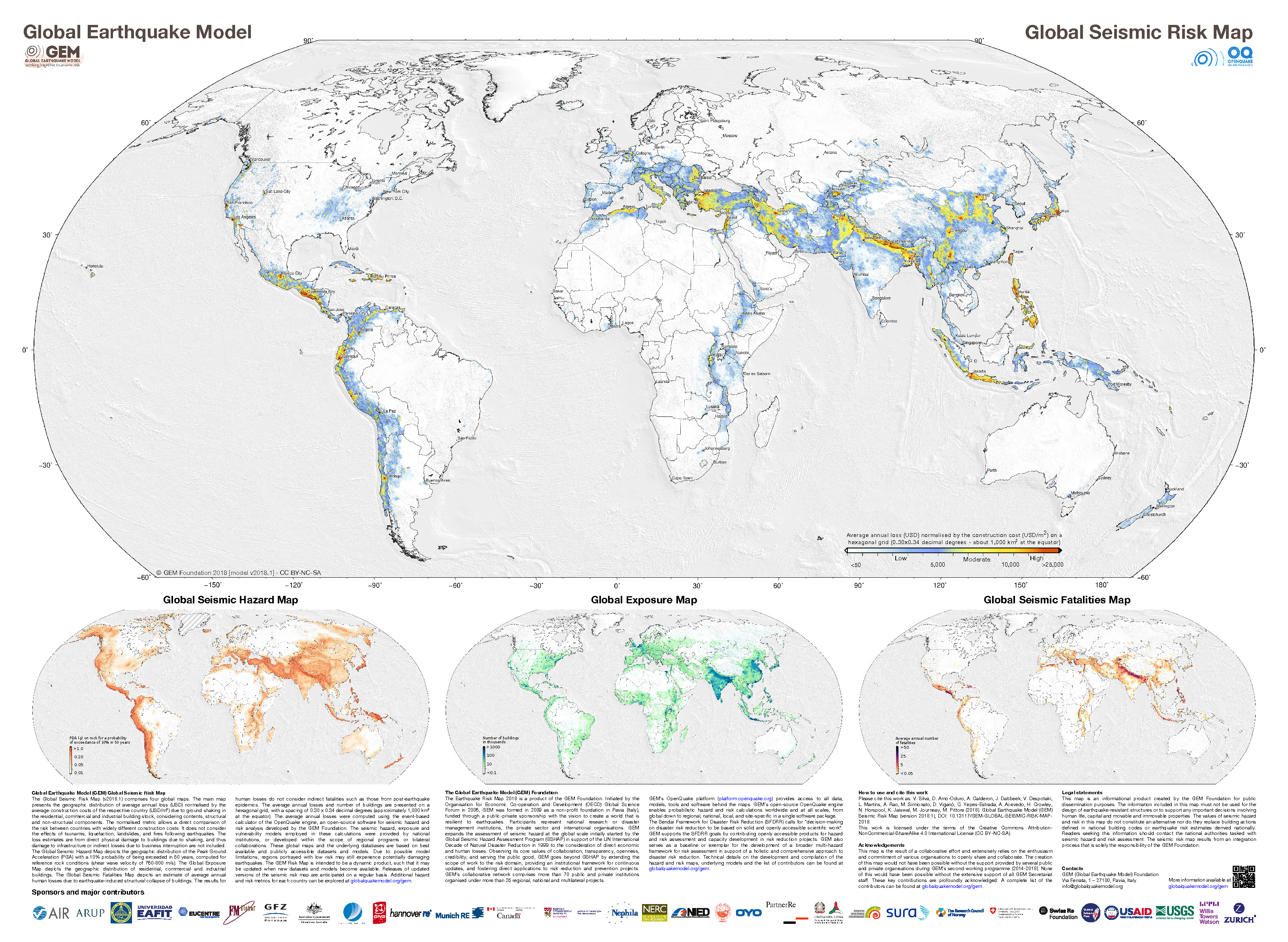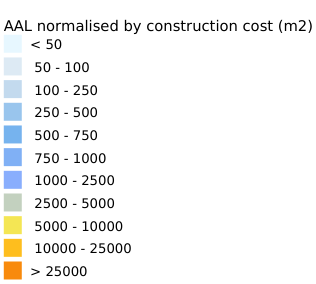Yesterday on my way home from a Phil & Graham Lesh show, I got a tsunami notification alert from the National Tsunami Warning Center. There was a magnitude M 6.9 earthquake offshore of Indonesia and there was no tsunami threat for the west coast of the US.
I pulled over to investigate and searched the USGS earthquakes page to locate this earthquake. At that time, there were two events spaced closely in time and space. I suspected that there was probably only one earthquake.
Shortly, that turned out to be true (within minutes). There was a M 7.1 earthquake north of the islands of Bali and Lombok, part of Indonesia.
https://earthquake.usgs.gov/earthquakes/eventpage/us7000krjx/executive
There was a series of earthquakes in this area a few years ago, which came to my mind. However, this M 7.1 was much deeper.
This M 7.1 earthquake was quite deep (over 500 km!). Those earlier events were shallower and appear to have been related to the Flores thrust fault. Read more about these shallower earthquakes here.
This part of the world is geologically dominated by the convergent plate margin between the Australia and Eurasia plates. This convergent plate margin is part of the Alpide belt, a convergent plate margin that spans almost half the globe (from the northern tip of Australia to the western tip of Portugal). The Alpide belt is responsible for building the tallest mountains in the world (the Asian Himalayas and the European Alps).
Here, in Indonesia, the Australia plate dives beneath the Australia plate forming a subduction zone and a deep sea trench (the Java trench). Earthquakes along this megathrust subduction zone fault have generated strong ground shaking, generated tsunami, and triggered landslides in the past.
In this part of the world, the Eurasia plate is subdivided into a sub-plate called the Sunda plate (so one might see maps with either name labeling this plate).
As the Australia plate subducts it starts out dipping shallowly beneath Java, Bali, Lombok, and the other islands.
The oceanic crust has water within it that helps generate melt in the magma that exists above the Australia plate and beneath the Sunda plate. When this magma melts, its density decreases and the magma rises until it erupts forming the volcanoes that comprise these islands.
As the Australia plate subducts further, the angle that it dips down into the Earth gets steeper. During this process the plate bends and gets exposed to higher pressures (and temperatures).
These physical processes change the stresses within and surrounding the plate. These changes in stress can cause earthquakes like the M 7.1.
Even though this earthquake was large in magnitude, it was so deep so that the shaking intensity was smaller.
The shaking intensity is often reported using the Modified Mercalli Intensity (MMI) scale. People (anyone with internet access) can report their observations on the USGS “Did You Feel It?” web page for this earthquake.
These observations are then used to estimate the shaking intensity felt by those people. Reports from this earthquake show that people on these nearby islands felt intensities around MMI 4 to MMI 5 or so.
Below is my interpretive poster for this earthquake
- I plot the seismicity from the past month, with diameter representing magnitude (see legend). I include earthquake epicenters from 1922-2022 with magnitudes M ≥ 3.0 in one version.
- I plot the USGS fault plane solutions (moment tensors in blue and focal mechanisms in orange), possibly in addition to some relevant historic earthquakes.
- A review of the basic base map variations and data that I use for the interpretive posters can be found on the Earthquake Reports page. I have improved these posters over time and some of this background information applies to the older posters.
- Some basic fundamentals of earthquake geology and plate tectonics can be found on the Earthquake Plate Tectonic Fundamentals page.
- In the upper right corner is a map showing historic seismicity and tectonic plate boundaries.
- Below that map is a low angle oblique view of a cut away of the Earth along the subduction zone in Java, Indonesia from EOS.
- In the upper left corner are maps that show the seismic hazard and seismic risk for Indonesia. I spend more time explaining this below.
- To the right of these hazard and risk maps is a map that shows earthquake intensity using the Modified Mercalli Intensity (MMI) Scale.
- Above the map is a plot that shows the same intensity (both modeled and reported) data as displayed on the map. Note how the intensity gets smaller with distance from the earthquake.
- In the lower right corner is a cross section showing earthquake hypocenters (3-D locations) from Darman et a. (2012).
- To the left of the Darman (2012) plot is a cross section of seismicity presented by Hengresh and Whitney (2016).
- In the lower center I plot USGS seismicity from the past century. I describe this further below.
I include some inset figures. Some of the same figures are located in different places on the larger scale map below. In some of these inset figures I place a blue star to locate the M 7.1 earthquake on these figures.
- Here is the plot with a century’s seismicity plotted.
- These data are limited to within the region shown on the map and i highlight the M 7.1 in orange.
- These are USGS hypocenters and epicenters for earthquakes between 1923 and 2023 for magnitudes M≥5.
- One may observe the seismicity within the Australia plate as the plate subducts downwards. The top of the crust is above these seismicity trends.
- If one looks closely, they will notice a horizontal line of earthquakes at about 30km. These are all with a default depth of 33 km. There is also a row of seismicity with a default depth of 10km. These are depths assigned to events prior to a location assigned with greater certainty. It is highly likely that the depths for these events is different than 10 or 33 km.
Other Report Pages
It's been a busy few days for earthquakes! We just released a post about yesterday's M7.1 ultra-deep quake in the Bali Sea. Yesterday we wrote about a M3.6 in Ohio, and the day before that a M5.7 in western Colombia. Subscribe to our newsletter – you'll become great at geography! pic.twitter.com/SE2FhLi4CJ
— Dr. Judith Hubbard (@JudithGeology) August 29, 2023
Here is Dr. Hubbard’s report: https://earthquakeinsights.substack.com/p/ultra-deep-m71-earthquake-in-indonesia
- Below is a map showing historic seismicity (Jones et al., 2014). Cross sections B-B’ and C-C’ are shown. The seismicity for the cross sections below are sourced from within each respective rectangle.
- Here are the seismcity cross sections.
- Here is the map from McCaffrey and Nabelek (1987). They used seismic reflection profiles, gravity modeling along these profiles, seismicity, and earthquake source mechanism analyses to support their interpretations of the structures in this region.
- Here is the Audley (2011) cross section showing how the backthrust relates to the subduction zone beneath Timor. I include their figure caption in blockquote below.
- This are the seismicity cross sections from Hangesh and Whitney (2016). These are shown to compare the subduction zone offshore of Java and the collision zone in the Timor region.
- Below are the maps and cross sections from Darman et al., 2012.
- Here is the map in the interpretive poster above.
- Here is the seismicity cross section in the interpretive poster above.
- Here is their interpretations of seismic data used to interpret the tectonics of the subduction zone and Flores thrust.
- Here is a figure showing the regional geodetic motions (Bock et al., 2003). I include their figure caption below as a blockquote.
- In addition to the orientation of relative plate motion (that controls seismogenic zone and strain partitioning), the Indo Australia plate varies in crustal age (Lasitha et al., 2006). I include their figure caption below as a blockquote.
- Below are the 4 figures from Koulani et al., 2016. First is the plate tectonic map. I include their figure captions in block quote.
- This figure shows their estimates for plate motion relative velocities as derived from GPS data, constrained by the fault geometry in their block modeling.
- This figure shows their estimates of slip rate deficit along all the plate boundary faults in this region.
- Here is their figure that shows the slip deficit along the plate boundary faults.
- These are the two maps shown in the map above, the GEM Seismic Hazard and the GEM Seismic Risk maps from Pagani et al. (2018) and Silva et al. (2018).
- The GEM Seismic Hazard Map:
- The Global Earthquake Model (GEM) Global Seismic Hazard Map (version 2018.1) depicts the geographic distribution of the Peak Ground Acceleration (PGA) with a 10% probability of being exceeded in 50 years, computed for reference rock conditions (shear wave velocity, VS30, of 760-800 m/s). The map was created by collating maps computed using national and regional probabilistic seismic hazard models developed by various institutions and projects, and by GEM Foundation scientists. The OpenQuake engine, an open-source seismic hazard and risk calculation software developed principally by the GEM Foundation, was used to calculate the hazard values. A smoothing methodology was applied to homogenise hazard values along the model borders. The map is based on a database of hazard models described using the OpenQuake engine data format (NRML). Due to possible model limitations, regions portrayed with low hazard may still experience potentially damaging earthquakes.
- Here is a view of the GEM seismic hazard map for Indonesia.
- The GEM Seismic Risk Map:
- The Global Seismic Risk Map (v2018.1) presents the geographic distribution of average annual loss (USD) normalised by the average construction costs of the respective country (USD/m2) due to ground shaking in the residential, commercial and industrial building stock, considering contents, structural and non-structural components. The normalised metric allows a direct comparison of the risk between countries with widely different construction costs. It does not consider the effects of tsunamis, liquefaction, landslides, and fires following earthquakes. The loss estimates are from direct physical damage to buildings due to shaking, and thus damage to infrastructure or indirect losses due to business interruption are not included. The average annual losses are presented on a hexagonal grid, with a spacing of 0.30 x 0.34 decimal degrees (approximately 1,000 km2 at the equator). The average annual losses were computed using the event-based calculator of the OpenQuake engine, an open-source software for seismic hazard and risk analysis developed by the GEM Foundation. The seismic hazard, exposure and vulnerability models employed in these calculations were provided by national institutions, or developed within the scope of regional programs or bilateral collaborations.
- Here is a view of the GEM seismic risk map for Indonesia.
- Here are two maps that show the results of probabilistic tsunami modeling for the nation of Indonesia (Horspool et al., 2014). These results are similar to results from seismic hazards analysis and maps. The color represents the chance that a given area will experience a certain size tsunami (or larger).
- The first map shows the annual chance of a tsunami with a height of at least 0.5 m (1.5 feet). The second map shows the chance that there will be a tsunami at least 3 meters (10 feet) high at the coast.
Some Relevant Discussion and Figures
Tectonic and geographic map of the eastern Sunda arc and vicinity. Active volcanoes are represented by triangles, and bathymetric contours are in kilometers. Thrust faults are shown with teeth on the upper plate. The dashed box encloses the study area.
Cartoon cross section of Timor today, (cf. Richardson & Blundell 1996, their BIRPS figs 3b, 4b & 7; and their fig. 6 gravity model 2 after Woodside et al. 1989; and Snyder et al. 1996 their fig. 6a). Dimensions of the filled 40 km deep present-day Timor Tectonic Collision Zone are based on BIRPS seismic, earthquake seismicity and gravity data all re-interpreted here from Richardson & Blundell (1996) and from Snyder et al. (1996). NB. The Bobonaro Melange, its broken formation and other facies are not indicated, but they are included with the Gondwana mega-sequence. Note defunct Banda Trench, now the Timor TCZ, filled with Australian continental crust and Asian nappes that occupy all space between Wetar Suture and the 2–3 km deep deformation front north of the axis of the Timor Trough. Note the much younger decollement D5 used exactly the same part of the Jurassic lithology of the Gondwana mega-sequence in the older D1 decollement that produced what appears to be much stronger deformation.
Comparison of hypocentral profiles across the (a) Java subduction zone and (b) Timor collision zone (paleo-Banda trench). Catalog compiled from multiple reporting agencies listed in Table 1. Events of Mw>4.0 are shown for period 1815 to 2015.
Tectonic map of the Lesser Sunda Islands, showing the main tectonic units, main faults, bathymetry and location of seismic sections discussed in this paper.
This plot shows the earthquake localizations on a South-North cross section for the lat -14°/-4° long 114°/124° quadrant corresponding to the Lesser Sunda Islands region. The localizations are extracted from the USGS database and corresponds to magnitude greater than 4.5 in the 1973-2004 time period (shallow earthquakes with undetermined depth have been omitted.
Six 15 km deep seismic sections acquired by BGR from west to east traversing oceanic crust, deep sea trench, accretionary prism, outer arc high and fore-arc basin, derived from Kirchoff prestack depth migration (PreSDM) with a frequency range of 4-60 Hz. Profile BGR06-313 shows exemplarily a velocity-depth model according to refraction/wide-angle
seismic tomography on coincident profile P31 (modified after Lüschen et al, 2011).
Topographic and tectonic map of the Indonesian archipelago and surrounding region. Labeled, shaded arrows show motion (NUVEL-1A model) of the first-named tectonic plate relative to the second. Solid arrows are velocity vectors derived from GPS surveys from 1991 through 2001, in ITRF2000. For clarity, only a few of the vectors for Sumatra are included. The detailed velocity field for Sumatra is shown in Figure 5. Velocity vector ellipses indicate 2-D 95% confidence levels based on the formal (white noise only) uncertainty estimates. NGT, New Guinea Trench; NST, North Sulawesi Trench; SF, Sumatran Fault; TAF, Tarera-Aiduna Fault. Bathymetry [Smith and Sandwell, 1997] in this and all subsequent figures contoured at 2 km intervals.
Tectonic sketch map of the Sumatra–Java trench-arc region in eastern Indian Ocean Benioff Zone configuration. Hatched line with numbers indicates depth to the top of the Benioff Zone (after Newcomb and McCann13). Magnetic anomaly identifications have been considered from Liu et al.14 and Krishna et al.15. Magnitude and direction of the plate motion is obtained from Sieh and Natawidjaja11. O indicates the location of the recent major earthquakes of 26 December 2004, i.e. the devastating tsunamigenic earthquake (Mw = 9.3) and the 28 March 2005 earthquake (Mw = 8.6).
Seismotectonic setting of the Sunda-Banda arc-continent collision, East Indonesia. Major faults (thick black lines) [Hamilton, 1979]. Topography and bathymetry are from Shuttle Radar Topography Mission (http://topex.ucsd.edu/www_html/srtm30_plus.html). Focal mechanisms are from the Global Centroid Moment Tensor. Blue mechanisms correspond to earthquakes with Mw>7 (brown transparent ellipses are the corresponding rupture areas for Flores 1992 and Alor 2004 earthquakes), while the green focal mechanism shows the highest magnitude recorded in Sumbawa. Red dots indicate the locations of major historical earthquakes [Musson, 2012].
GPS velocities determined in this study with respect to Sunda Block. Uncertainty ellipses represent 95% confidence level. The inset figure corresponds to the area of the dashed rectangle in the map. Light blue arrows show the velocities for East and West Makassar Blocks.
Relative slip vectors across block boundaries, derived from our best fit model. Arrows show motion of the hanging wall (moving block) relative to the footwall (fixed block) with 95% confidence ellipses. The tails of arrows is located within the “moving” block. Black thick lines show well-defined boundaries we use as active faults in our model and dashed lines show less well-defined boundaries (green : free-slipping boundaries and black: fixed locked faults) . Principal axes of the horizontal strain tensor estimated for the SUMB, EMAK, and EJAV are shown in pink. The thick pink arrow shows the relative motion of Australia with respect to Sunda (AUST/SUND). Abbreviations are Sumba Block (SUMB), West Makassar Block (WMAK), East Makassar Block (EMAK), East Java Block (EJAV), and Timor Block (TIMO). The background seismicity is from the International Seismological Centre catalog with magnitudes ≥5.5 and depths <40 km.
Fault slip rate components: (a) fault normal (extension positive) and (b) fault parallel (right-lateral positive).
Seismic Hazard and Seismic Risk
Tsunami Hazard
Annual probability of experiencing a tsunami with a height at the coast of (a) 0.5m (a tsunami warning) and (b) 3m (a major tsunami warning).
- M 9.2 Andaman-Sumatra subduction zone 2014 Earthquake Anniversary
- M 9.2 Andaman-Sumatra subduction zone SASZ Fault Deformation
- M 9.2 Andaman-Sumatra subduction zone 2016 Earthquake Anniversary
- 2023.08.28 M 7.1 Lombok & Bali, Indonesia
- 2023.04.24 M 7.1 Sumatra
- 2022.11.18 M 6.9 Sumatra
- 2022.02.25 M 6.2 Sumatra
- 2020.05.06 M 6.8 Banda Sea
- 2019.08.02 M 6.9 Indonesia
- 2019.06.23 M 7.3 Banda Sea
- 2019.04.12 M 6.8 Sulawesi, Indonesia
- 2018.09.28 M 7.5 Sulawesi
- 2018.10.16 M 7.5 Sulawesi UPDATE #1
- 2018.08.19 M 6.9 Lombok, Indonesia
- 2018.08.05 M 6.9 Lombok, Indonesia
- 2018.07.28 M 6.4 Lombok, Indonesia
- 2017.12.15 M 6.5 Java
- 2017.08.31 M 6.3 Mentawai, Sumatra
- 2017.08.13 M 6.4 Bengkulu, Sumatra, Indonesia
- 2017.05.29 M 6.8 Sulawesi, Indonesia
- 2017.03.14 M 6.0 Sumatra
- 2017.03.01 M 5.5 Banda Sea
- 2016.10.19 M 6.6 Java
- 2016.03.02 M 7.8 Sumatra/Indian Ocean
- 2015.07.22 M 5.8 Andaman Sea
- 2015.11.08 M 6.4 Nicobar Isles
- 2012.04.11 M 8.6 Sumatra outer rise
- 2004.12.26 M 9.2 Andaman-Sumatra subduction zone
Indonesia | Sumatra
General Overview
Earthquake Reports
Social Media
#EarthquakeReport for M7.1 #Gempa #Earthquake offshore of #Lombok #Bali #Indonesia
Probably in subducted Australia plate
Possibly normal faulting eventRead report for event in similar region https://t.co/i5eSZKqY8Yhttps://t.co/sD5WZ1pIQb pic.twitter.com/YYtB9Zpjnb
— Jason "Jay" R. Patton (@patton_cascadia) August 28, 2023
#EarthquakeReport for M7.1 #Gempa #Earthquake offshore of #Lombok #Bali #Indonesia
deep intraplate
within subducted Australia plate
normal faulting event
hi res poster https://t.co/EgD5mNCxSHreport for '18 event in same region: https://t.co/i5eSZKqY8Yhttps://t.co/sD5WZ1pIQb pic.twitter.com/kCw48mLLkO
— Jason "Jay" R. Patton (@patton_cascadia) August 29, 2023
#EarthquakeReport for M7.1 #Gempa #Earthquake offshore of #Lombok & #Bali #Indonesia
deep intraplate event in Australia plate
normal-oblique earthquake mechanismreport written here:https://t.co/FD7tmQA2yJ pic.twitter.com/xaty2hrJb9
— Jason "Jay" R. Patton (@patton_cascadia) August 30, 2023
Recent 7.1 Mw (#INDONESIA 🇮🇩), a deep instraslab, down a hole in the slab?, no tsunami. pic.twitter.com/huGez4R57M
— Abel Seism🌏Sánchez (@EQuake_Analysis) August 28, 2023
Mw=7.1, BALI SEA (Depth: 522 km), 2023/08/28 19:55:32 UTC – Full details here: https://t.co/aPvQGHEpSI pic.twitter.com/ybGehxAvE1
— Earthquakes (@geoscope_ipgp) August 28, 2023
There is no tsunami danger.
Tsunami Info Stmt: M6.9 Bali Sea 1257PDT
Aug 28: Tsunami NOT expected; CA, OR, WA, BC, and AK— NWS Tsunami Alerts (@NWS_NTWC) August 28, 2023
This seismic station near Havana, Cuba shows the incoming tropical storm (#Idalia) & the M7.1 earthquake in the Bali Sea.
The storm is visible as thicker “wiggles” in the seismic data. This is the seismic signal of the big waves pounding on the coasts and sea floor. pic.twitter.com/L0g5SCsJES
— Wendy Bohon, PhD 🌏 (@DrWendyRocks) August 28, 2023
A deep (~515 km) M7.1 earthquake occurred in the Bali Sea. Use Station Monitor to see the waves from this earthquake recorded at seismic stations around the world.
➡️ https://t.co/Tir0KZEe8f pic.twitter.com/AvMUSWzvi6
— EarthScope Consortium (@EarthScope_sci) August 28, 2023
Notable quake, preliminary info: M 7.1 – Bali Sea https://t.co/nBlmJ2rQia
— USGS Earthquakes (@USGS_Quakes) August 28, 2023
#Earthquake recorded on the #RaspberryShake #CitizenScience seismic network. See what's shaking near you with the @raspishake #ShakeNet mobile app pic.twitter.com/iaZX7FKeLB
— Ryan Hollister (@phaneritic) August 28, 2023
No #tsunami threat to Australia from magnitude 7.0 #earthquake near Bali Sea. Latest advice at https://t.co/Tynv3ZQpEq. pic.twitter.com/iA5CbBtdPi
— Bureau of Meteorology, Australia (@BOM_au) August 28, 2023
Selasa 29 Agus 2023 pukul 02.55.32 WIBLaut Jawa (Utara Lombok) diguncang gempa. Hasil analisis BMKG menunjukkan gempa ini memiliki parameter update M7,1. Episente pada koordinat 6,94° LS ; 116,57° BT, tepatnya di laut 163 Km arah Timur Laut Lombok Utara, NTB kedalaman 525 km. pic.twitter.com/uAtA735Ujw
— DARYONO BMKG (@DaryonoBMKG) August 28, 2023
The M7.1 earthquake in the Bali Sea was a deep earthquake (~515 km) that occurred where the Australian Plate subducts beneath the Sunda Plate, the southeastern promontory on the Eurasian Plate. Earthquakes within the Australia Plate increase in depth from south to north. pic.twitter.com/Qzi6gbWqIa
— EarthScope Consortium (@EarthScope_sci) August 28, 2023
Almost two hours ago, Mw7.1 #earthquake at Bali Sea, Indonesia. Very deep (h=520 km), it was felt in Java, Bali, Lombok, Sumbawa, Borneo, Celebes and other islands. Thanks to depth, no major damage is expected. Similar EQ in 1937.https://t.co/aJ9UTztiqThttps://t.co/7KROBZ0w20 pic.twitter.com/hwRySyJr7U
— José R. Ribeiro (@JoseRodRibeiro) August 28, 2023
Hasil analisis mekanisme sumber menunjukkan bahwa gempabumi Utara Lombok ini memiliki mekanisme pergerakan kombinasi pergerakan mendatar turun (oblique normal). pic.twitter.com/iHai9qqrbZ
— DARYONO BMKG (@DaryonoBMKG) August 28, 2023
Although the Bali Sea #earthquake is big with magnitude M7.1, a tsunami is very unlikely because the earthquake was very deep occurring at depth of 513 km (see the photo). #Indonesia #tsunami #resilience pic.twitter.com/KzRrQlfxRi
— Dr Mohammad Heidarzadeh (@Mo_Heidarzadeh) August 28, 2023
Watch the waves from the M7.1 earthquake in the Bali Sea roll across seismic stations in North America. (THREAD 🧵) pic.twitter.com/aTmRqDcpuw
— EarthScope Consortium (@EarthScope_sci) August 29, 2023
Recent Earthquake Teachable Moment for the M7.1 Bali Sea, Indonesia earthquake.
Teachable Moments presentations capture the opportunity to bring knowledge, insight, and critical thinking to the classroom following a newsworthy earthquake.
➡️ https://t.co/daC3ijKUFx pic.twitter.com/rvchwIfDoh
— EarthScope Consortium (@EarthScope_sci) August 29, 2023
It's been a busy few days for earthquakes! We just released a post about yesterday's M7.1 ultra-deep quake in the Bali Sea. Yesterday we wrote about a M3.6 in Ohio, and the day before that a M5.7 in western Colombia. Subscribe to our newsletter – you'll become great at geography! pic.twitter.com/SE2FhLi4CJ
— Dr. Judith Hubbard (@JudithGeology) August 29, 2023
- Frisch, W., Meschede, M., Blakey, R., 2011. Plate Tectonics, Springer-Verlag, London, 213 pp.
- Hayes, G., 2018, Slab2 – A Comprehensive Subduction Zone Geometry Model: U.S. Geological Survey data release, https://doi.org/10.5066/F7PV6JNV.
- Holt, W. E., C. Kreemer, A. J. Haines, L. Estey, C. Meertens, G. Blewitt, and D. Lavallee (2005), Project helps constrain continental dynamics and seismic hazards, Eos Trans. AGU, 86(41), 383–387, , https://doi.org/10.1029/2005EO410002. /li>
- Jessee, M.A.N., Hamburger, M. W., Allstadt, K., Wald, D. J., Robeson, S. M., Tanyas, H., et al. (2018). A global empirical model for near-real-time assessment of seismically induced landslides. Journal of Geophysical Research: Earth Surface, 123, 1835–1859. https://doi.org/10.1029/2017JF004494
- Kreemer, C., J. Haines, W. Holt, G. Blewitt, and D. Lavallee (2000), On the determination of a global strain rate model, Geophys. J. Int., 52(10), 765–770.
- Kreemer, C., W. E. Holt, and A. J. Haines (2003), An integrated global model of present-day plate motions and plate boundary deformation, Geophys. J. Int., 154(1), 8–34, , https://doi.org/10.1046/j.1365-246X.2003.01917.x.
- Kreemer, C., G. Blewitt, E.C. Klein, 2014. A geodetic plate motion and Global Strain Rate Model in Geochemistry, Geophysics, Geosystems, v. 15, p. 3849-3889, https://doi.org/10.1002/2014GC005407.
- Meyer, B., Saltus, R., Chulliat, a., 2017. EMAG2: Earth Magnetic Anomaly Grid (2-arc-minute resolution) Version 3. National Centers for Environmental Information, NOAA. Model. https://doi.org/10.7289/V5H70CVX
- Müller, R.D., Sdrolias, M., Gaina, C. and Roest, W.R., 2008, Age spreading rates and spreading asymmetry of the world’s ocean crust in Geochemistry, Geophysics, Geosystems, 9, Q04006, https://doi.org/10.1029/2007GC001743
- Pagani,M. , J. Garcia-Pelaez, R. Gee, K. Johnson, V. Poggi, R. Styron, G. Weatherill, M. Simionato, D. Viganò, L. Danciu, D. Monelli (2018). Global Earthquake Model (GEM) Seismic Hazard Map (version 2018.1 – December 2018), DOI: 10.13117/GEM-GLOBAL-SEISMIC-HAZARD-MAP-2018.1
- Silva, V ., D Amo-Oduro, A Calderon, J Dabbeek, V Despotaki, L Martins, A Rao, M Simionato, D Viganò, C Yepes, A Acevedo, N Horspool, H Crowley, K Jaiswal, M Journeay, M Pittore, 2018. Global Earthquake Model (GEM) Seismic Risk Map (version 2018.1). https://doi.org/10.13117/GEM-GLOBAL-SEISMIC-RISK-MAP-2018.1
- Storchak, D. A., D. Di Giacomo, I. Bondár, E. R. Engdahl, J. Harris, W. H. K. Lee, A. Villaseñor, and P. Bormann (2013), Public release of the ISC-GEM global instrumental earthquake catalogue (1900–2009), Seismol. Res. Lett., 84(5), 810–815, doi:10.1785/0220130034.
- Zhu, J., Baise, L. G., Thompson, E. M., 2017, An Updated Geospatial Liquefaction Model for Global Application, Bulletin of the Seismological Society of America, 107, p 1365-1385, https://doi.org/0.1785/0120160198
- Audley-Charles, M.G., 1986. Rates of Neogene and Quaternary tectonic movements in the Southern Banda Arc based on micropalaeontology in: Journal of the Geological Society, London, Vol. 143, 1986, pp. 161-175.
- Audley-Charles, M.G., 2011. Tectonic post-collision processes in Timor, Hall, R., Cottam, M. A. &Wilson, M. E. J. (eds) The SE Asian Gateway: History and Tectonics of the Australia–Asia Collision. Geological Society, London, Special Publications, 355, 241–266.
- Baldwin, S.L., Fitzgerald, P.G., and Webb, L.E., 2012. Tectonics of the New Guinea Region in Annu. Rev. Earth Planet. Sci., v. 41, p. 485-520.
- Benz, H.M., Herman, Matthew, Tarr, A.C., Hayes, G.P., Furlong, K.P., Villaseñor, Antonio, Dart, R.L., and Rhea, Susan, 2011. Seismicity of the Earth 1900–2010 New Guinea and vicinity: U.S. Geological Survey Open-File Report 2010–1083-H, scale 1:8,000,000.
- Darman, H., 2012. Seismic Expression of Tectonic Features in the Lesser Sunda Islands, Indonesia in Berita Sedimentologi, Indonesian Journal of Sedimentary Geology, no. 25, po. 16-25.
- Hall, R., 2011. Australia-SE Asia collision: plate tectonics and crustal flow in Geological Society, London, Special Publications 2011; v. 355; p. 75-109 doi: 10.1144/SP355.5
- Hangesh, J. and Whitney, B., 2014. Quaternary Reactivation of Australia’s Western Passive Margin: Inception of a New Plate Boundary? in: 5th International INQUA Meeting on Paleoseismology, Active Tectonics and Archeoseismology (PATA), 21-27 September 2014, Busan, Korea, 4 pp.
- Hayes, G.P., Wald, D.J., and Johnson, R.L., 2012. Slab1.0: A three-dimensional model of global subduction zone geometries in, J. Geophys. Res., 117, B01302, doi:10.1029/2011JB008524
- Jones, E.S., Hayes, G.P., Bernardino, Melissa, Dannemann, F.K., Furlong, K.P., Benz, H.M., and Villaseñor, Antonio, 2014. Seismicity of the Earth 1900–2012 Java and vicinity: U.S. Geological Survey Open-File Report 2010–1083-N, 1 sheet, scale 1:5,000,000, https://dx.doi.org/10.3133/ofr20101083N.
- Koulali, A., S. Susilo, S. McClusky, I. Meilano, P. Cummins, P. Tregoning, G. Lister, J. Efendi, and M. A. Syafi’i, 2016. Crustal strain partitioning and the associated earthquake hazard in the eastern Sunda-Banda Arc in Geophys. Res. Lett., 43, 1943–1949, doi:10.1002/2016GL067941
- Krabbenhoeft, A., Weinrebe, R.W., Kopp, H., Flueh, E.R., Ladage, S., Papenberg, C., Planert, L., and Djajadihardja, Y., 2010. Bathymetry of the Indonesian Sunda margin-relating morphological features of the upper plate slopes to the location and extent of the seismogenic zone in NHESS, v. 10, p. 1899-1911, doi:10.5194/nhess-10-1899-2010
- McCaffrey, R., and Nabelek, J.L., 1984. The geometry of back arc thrusting along the Eastern Sunda Arc, Indonesia: Constraints from earthquake and gravity data in JGR, Atm., vol., 925, no. B1, p. 441-4620, DOI: 10.1029/JB089iB07p06171
- Okal, E. A., & Reymond, D., 2003. The mechanism of great Banda Sea earthquake of 1 February 1938: applying the method of preliminary determination of focal mechanism to a historical event in EPSL, v. 216, p. 1-15.
- Silver, E.A., Breen, N.A., and Prastyo, H., 1986. Multibeam Study of the Flores Backarc Thrust Belt, Indonesia, in JGR., vol. 91, no. B3, p. 3489-3500
- Zahirovic, S., Seton, M., and Müller, R.D., 2014. The Cretaceous and Cenozoic tectonic evolution of Southeast Asia in Solid Earth, v. 5, p. 227-273, doi:10.5194/se-5-227-2014
References:
Basic & General References
Specific References
Return to the Earthquake Reports page.
- Sorted by Magnitude
- Sorted by Year
- Sorted by Day of the Year
- Sorted By Region
